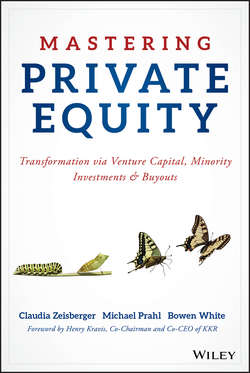Читать книгу Mastering Private Equity - Prahl Michael - Страница 8
На сайте Литреса книга снята с продажи.
SECTION I
PRIVATE EQUITY OVERVIEW
1
PRIVATE EQUITY ESSENTIALS
ОглавлениеAt some point in their development, all companies will need either a helping hand or a shot in the arm. A fresh injection of capital or external managerial expertise is often necessary to help organizations overcome developmental challenges, realize their full potential and seize the opportunities that lie ahead. Start-ups hunt for the visionary capital that will enable them to turn a concept into a launched product. Mature companies are increasingly subject to market disruption, increased competition or pressure to update manufacturing processes and corporate governance structures. Companies that have been performing poorly for a prolonged period of time need to identify and then rectify the problems that confront them. Family businesses must honestly address succession planning (“it is only but three generations from shirtsleeves to shirtsleeves”3).
The needs and demands of businesses at such critical inflection points often exceed the capabilities and services provided by the established financial institutions and consulting firms. Capital markets, for instance, are unlikely to offer a solution for small and medium-sized enterprises (SMEs). Into this void steps private equity (PE) in the form of venture, growth, and buyout funds, at its best offering patient and long-term capital, dedicated expert advice and hands-on operational support.
In the last four decades PE has emerged as the transformation agent of choice for companies seeking change; at times, it is the only choice for a business in need of capital and a risk-sharing partner to facilitate future growth. The PE ecosystem has grown dramatically during that time; as of 2015 the industry (including its alternative strategies and co-investments) has over US$4.5 trillion in assets under management, of which US$2.3 trillion are deployed through core PE strategies. This capital is being invested and managed by over 8,000 professional funds globally. Understanding this industry – its drivers and its dynamics – is a must for entrepreneurs, owners of family businesses, board members of multinationals and senior managers.
So what exactly is PE? PE funds invest long-term capital in private (or, at times, public) companies in return for an equity stake that is not freely tradable on a public market.4 Our definition of PE includes so-called “take-privates” (i.e., delistings of public companies) and private investment in public equity that come with specific governance rights. This book focuses strictly on the activity of professionally managed PE funds advised by highly specialized intermediaries (PE firms) and excludes “informal” private capital, such as investments made by business angels or families who typically draw on their own private wealth.
This first chapter gives our readers a high-level overview of PE funds, by defining their structure and the motivation of the key players involved. We then explain how PE funds go about their business, both from the general partner’s (GP’s) and limited partner’s (LP’s) perspective and shed light on the often complex economics and fee structures in PE.
3
Origin unknown but the quote is often attributed to Andrew Carnegie.
4
In our context, PE takes on a broad definition that includes VC, growth capital, and buyout funds. It should be mentioned that other sources might restrict the definition of PE to buyout activities and consider VC to be a separate asset class. Further, PE is frequently defined as investments in private companies but buyout activities extend to investments in and the privatization of public companies. For the sake of clarity, our definition of “private” equity refers to the status of the equity stake held by the PE fund post-investment.
